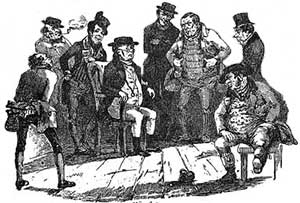The Charles Dickens Page
Charles Dickens'
The Pickwick Papers
The Posthumous Papers of the Pickwick Club
The Pickwick Papers - Published in monthly parts Mar 1836 - Oct 1837
Illustrations | Locations | Characters | More | Shop for the Book | Shop for the Video
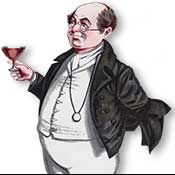
Samuel Pickwick by Joseph Clayton Clarke (Kyd) (1857-1937)
When artist Robert Seymour proposed to publishers Chapman and Hall a series of engravings featuring Cockney sporting life, with accompanying text published in monthly installments, they readily accepted and set about the task of finding a writer.
The publishers were turned down by Charles Whitehead, a writer in their employ, and he recommended 24-year-old Charles Dickens to provide the text. Dickens accepted and argued successfully that the text should be foremost and the engravings should complement the story (Ackroyd, 1990, p. 177-178).
Seymour, an established artist but without recent success, was troubled with the direction the upstart writer was taking his project and with Dickens' suggestions of changes to the illustrations. On completion of the two engravings for the second monthly part of Pickwick, Seymour, who had been depressed about his finances, and about the direction his career was going, walked into his garden on the morning of April 20, and committed suicide (Schlicke, 1999, p. 523-525).
Chapman and Hall decided to continue with the project and, after trying artist R. W. Buss, whose work was deemed unsatisfactory, hired 20-year-old Hablot Knight Browne as illustrator. Browne, who took the nickname "Phiz" to complement Dickens' "Boz" (Johnson, 1952, p. 141-142), went on to illustrate Dickens' work for the next 23 years.

Dickens took an active role in redesigning the project, the format was changed from 24 pages of text and four illustrations to 32 pages of text and two illustrations (Davis, 1999, p. 314). Dickens also abandoned the original concept of the "sporting club", which had been Seymour's idea (Dickens noted that despite spending a portion of his childhood in the country, that he was no sportsman (Schlicke, 1999, p. 444)) and began to tie the sketches together into a more cohesive novel.
The novel, a still somewhat loose collection of the adventures of Samuel Pickwick and his friends, was a huge success. Chapman and Hall printed only 1000 copies of the first monthly installment, at the end of serialization 40,000 copies were being printed (Schlicke, 1999, p. 449). Pickwick had taken Britain, and later the world, by storm and had successfully launched Charles Dickens to celebrity status.
Complete List of Characters
(contain spoilers)
Pickwick Links:
The Victorian Web
Bartleby.com
Wikipedia - Pickwick Papers
Further Information
Mr. Pickwick in the Fleet
When Mr Pickwick's landlady, Martha Bardell, brings a breach of promise suit against him and wins, the innocent Pickwick refuses to pay the damages, opting instead to be consigned to the Fleet debtor's prison.
Upon entering the Fleet he undergoes an initiation known as "sitting for your portrait" where all of the turnkeys (jailers) study Mr. Pickwick's appearance to differentiate him from visitors to the prison who are allowed to come and go during the day.
Pickwick is appalled at conditions in the prison but is later told by a fellow prisoner that "money was, in the Fleet, just what money was out of it" (Pickwick Papers, p. 592) and is able to purchase a furnished private room where he remains for three months.
Imprisonment for debt is a theme Charles Dickens uses frequently, his father having been imprisoned in the Marshalsea debtor's prison when Dickens was a child (Forster, 1899, v. 1, p. 22-39).
Samuel Weller
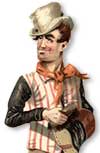 The popularity of The Pickwick Papers increased dramatically with the introduction, in chapter 10, of Pickwick's servant Samuel Weller, who councils his master with charming Cockney wisdom (Johnson, 1952, p. 148-149).
The popularity of The Pickwick Papers increased dramatically with the introduction, in chapter 10, of Pickwick's servant Samuel Weller, who councils his master with charming Cockney wisdom (Johnson, 1952, p. 148-149).
Wellerisms
The colorful dialogue of Sam Weller and his father, Tony, in Pickwick Papers is peppered with what have become known as Wellerisms (Merriam-Webster Dictionary). Learn more and see a list of Wellerisms found in Pickwick Papers.
V as W...and Vise Versa
 If you've read Dickens you have unquestionably come across the extraordinary curiosity of cockney characters interchanging V and W. Thus we have ven for when, vich for which, wery for very, and dewote for devote. Nowhere is this phenomenon more obvious than in the dialogue of Sam Weller and his father Tony in Pickwick Papers.
If you've read Dickens you have unquestionably come across the extraordinary curiosity of cockney characters interchanging V and W. Thus we have ven for when, vich for which, wery for very, and dewote for devote. Nowhere is this phenomenon more obvious than in the dialogue of Sam Weller and his father Tony in Pickwick Papers.
'What's your name, sir?' inquired the judge.
'Sam Weller, my Lord,' replied that gentleman.
'Do you spell it with a "V" or a "W"?' inquired the judge.
'That depends upon the taste and fancy of the speller, my Lord,' replied Sam; 'I never had occasion to spell it more than once or twice in my life, but I spells it with a "V." '
Learn more about this at John Wells's phonetic blog
Excerpts from Pickwick Papers
The Goblins Who Stole a Sexton Mr Wardle, at the Christmas Eve party at Dingley Dell, tells the story of Gabriel Grub, a morose and melancholy sexton and gravedigger in a village churchyard. Grub, an old curmudgeon at odds with the world, dreams he is visited by a host of goblins on Christmas Eve and changes his ways. The story is considered a precursor to A Christmas Carol.
Equestrian Journey to Dingley Dell
Samuel Pickwick and his fellow travelers, Tracy Tupman, Nathaniel Winkle, and Augustus Snodgrass, are traveling from Rochester to their friend Mr Wardle's residence at Manor Farm, Dingley Dell, a journey of about 15 miles. The travelers' inexperience at handling horses is evident in this comic adventure.
Mr Pickwick Meets the Lady in Yellow Curl Papers
In one of the funniest episodes in the novel, Samuel Pickwick and his servant, Sam Weller, have traveled to Ipswich in search of the rascal Alfred Jingle, taking rooms in the Great White Horse Inn. Mr Pickwick is ready to retire for the night when he realizes he has left his watch on the dinner table downstairs and determines to go and get it.
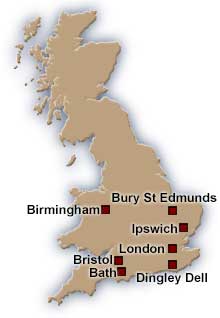
Pickwick locations in Britain
A Father's Adwise...
 'I've only this here one little bit of adwice to give you. If ever you gets to up'ards o' fifty, and feels disposed to go a-marryin' anybody--no matter who--jist you shut yourself up in your own room, if you've got one, and pison yourself off hand. Hangin's wulgar, so don't you have nothin' to say to that. Pison yourself, Samivel, my boy, pison yourself, and you'll be glad on it arterwards.'
'I've only this here one little bit of adwice to give you. If ever you gets to up'ards o' fifty, and feels disposed to go a-marryin' anybody--no matter who--jist you shut yourself up in your own room, if you've got one, and pison yourself off hand. Hangin's wulgar, so don't you have nothin' to say to that. Pison yourself, Samivel, my boy, pison yourself, and you'll be glad on it arterwards.'
-Tony Weller (Pickwick Papers, p. 315)
Charles Dickens' life during the serialization of The Pickwick Papers
Mar 1836 - Oct 1837
Dickens' age: 24-25
March 1836
April 1836Marries Catherine Hogarth (Kaplan, 1988, p. 71).
Original Pickwick Papers illustrator Robert Seymour commits suicide. Hablot Browne replaces him (Ackroyd, 1990, p. 182-183).
November 1836
Dickens agrees to edit Bentley's Miscellany, resigns as reporter for the Morning Chronicle (Ackroyd, 1990, p. 201-202).
January 1837
Son Charles Culliford (Charley) Dickens Born (Slater, 2009, p. 93-94).
February 1837
First Installment of Oliver Twist published in Bentley's Miscellany (Johnson, 1952, p. 189).
March 1837
Moves from chambers at Furnival's Inn to a house at 48 Doughty Street (Johnson, 1952, p. 191-192).
May 1837
Catherine's sister Mary Hogarth dies (Ackroyd, 1990, p. 225).
June 1837
Grieving for his beloved sister-in-law Dickens misses deadlines for the only time in his life. Monthly issues of Pickwick Papers and Oliver Twist are not published (Ackroyd, 1990, p. 228).
October 1837
Coaching Inns
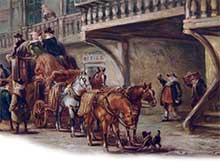 The Pickwick Papers, which Charles Dickens sets in the late 1820's, has Samuel Pickwick and his fellow travelers tour southern England by coach. This manner of travel began to disappear in the next decade as the railway covered Britain (Maskell, 1911, p. 85). Coaching inns mentioned in the novel with descriptions provided by B.W. Matz's The Inns and Taverns of Pickwick (Matz, 1921):
The Pickwick Papers, which Charles Dickens sets in the late 1820's, has Samuel Pickwick and his fellow travelers tour southern England by coach. This manner of travel began to disappear in the next decade as the railway covered Britain (Maskell, 1911, p. 85). Coaching inns mentioned in the novel with descriptions provided by B.W. Matz's The Inns and Taverns of Pickwick (Matz, 1921):
White Hart Inn - The Borough
The Leather Bottle Inn - Cobham
Great White Horse - Ipswich
Blue Boar - Leadenhall Market
Garraway's - London
White Horse Cellar - London
George and Vulture - London
The Bull - Whitechapel
Black Boy - Chelmsford
Magpie and Stump - London
White Hart Hotel - Bath
La Belle Sauvage - Dorking
Bell - Berkeley Heath
Old Royal Hotel - Birmingham
Hop Pole - Tewkesbury
Bush Tavern - Bristol
The Angel - Bury St. Edmunds
Golden Cross Hotel - Charing Cross, London
The Bull Inn - Rochester
Saracen's Head - Towcester
Pickwick and Don Quixote
 Comparisons have been made between the idealistic Mr Pickwick and his faithful servant Samuel Weller and Cervante's Don Quixote and Sancho Panza (Welsh, 1967, p. 19-30), (Potau, 1993, p. 105-110).
Comparisons have been made between the idealistic Mr Pickwick and his faithful servant Samuel Weller and Cervante's Don Quixote and Sancho Panza (Welsh, 1967, p. 19-30), (Potau, 1993, p. 105-110).
Cursing in Dickens
As the stricter morals of the Victorian era replaced the ribaldry of the 18th-century,  Dickens felt compelled to clean up his act. Instances of cursing in the novels dropped dramatically in his mid and late career. For example, below is a count of the full-use of the word "damn" (as opposed to just a capital D or d--d for damn or damned) in Dickens' works:
Dickens felt compelled to clean up his act. Instances of cursing in the novels dropped dramatically in his mid and late career. For example, below is a count of the full-use of the word "damn" (as opposed to just a capital D or d--d for damn or damned) in Dickens' works:
7 - Sketches by Boz
29 - Pickwick Papers
12 - Nicholas Nickleby
8 - Barnaby Rudge
1 - David Copperfield
3 - Bleak House
3 - Hard Times
3 - Little Dorrit
1 - Tale of Two Cities
3 - Great Expectations
1 - Our Mutual Friend
2 - Edwin Drood
Moses Pickwick
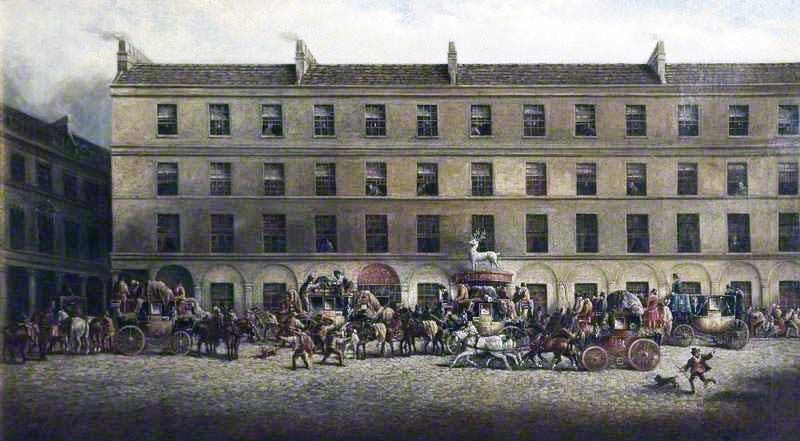
White Hart Hotel, Bath by John Charles Maggs 1869
Charles Dickens first visited Bath in 1835 as a young reporter covering Lord John Russell’s tour of England and stayed at the Saracen’s Head on Broad Street (Matz, 1921, 175-176). In Bath Dickens would have been aware of the name Pickwick blazoned on the side of coaches owned by Moses Pickwick and based at the White Hart Hotel (Matz, 1921, 173-174). Thus, Dickens had the name of his protagonist and even mentions Moses in the book:
"The names is not only down on the vay-bill, Sir," replied Sam, "but they’ve painted vun on ’em up, on the door o’ the coach." As Sam spoke, he pointed to that part of the coach door on which the proprietor's name usually appears; and there sure enough, in gilt letters of a goodly size, was the magic name of PICKWICK! (Pickwick Papers, p. 493)
Dickens also has the Pickwickians stay at the White Hart Hotel while in Bath.
Jane Austin also uses the White Hart Hotel as a location in her novel Persuasion (Austen, 2003, 206).
Pickwickian Travels
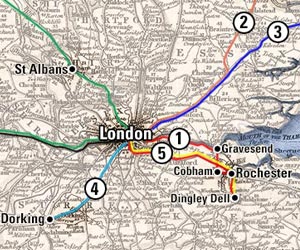
Explore a map of the adventures of Samuel Pickwick and his friends.
